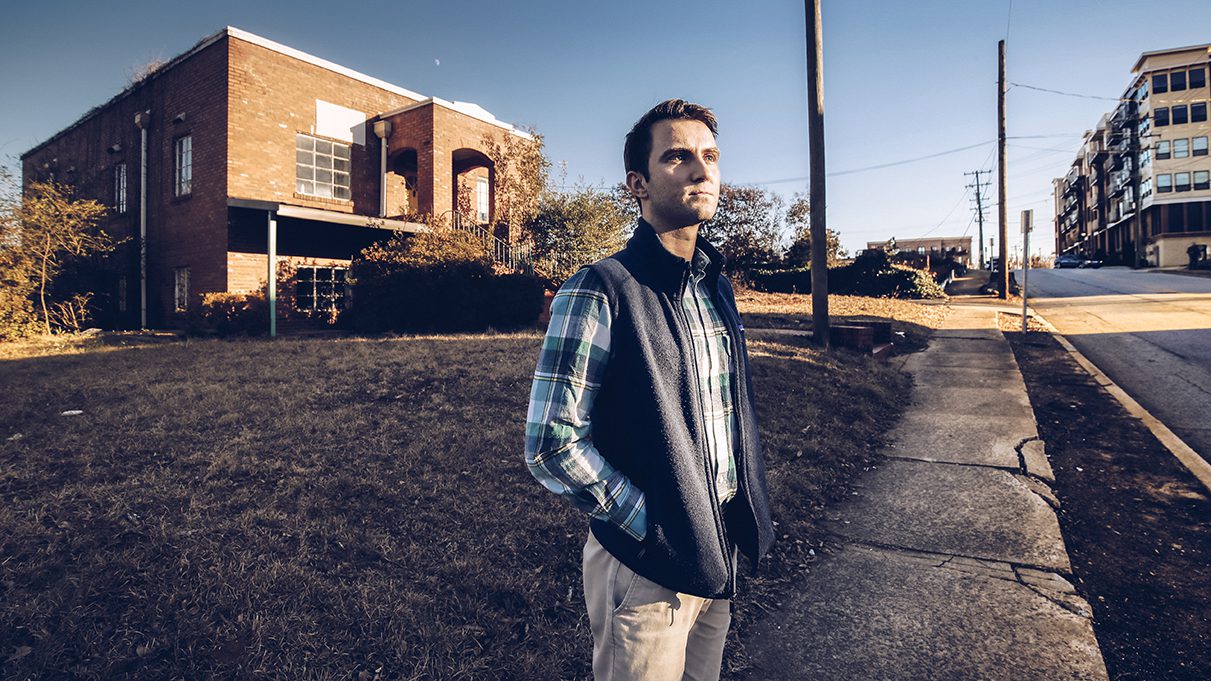Sam Hayes ’20 brings passion for preserving historical buildings to Greenville

You’d be hard-pressed to find a list of historical cities in America that doesn’t include Charleston, South Carolina. You’d also be hard-pressed to find one that does include Greenville.
Growing up in the former instilled a great appreciation for the past in Sam Hayes ’20, while living in the latter as a Furman student has inspired him to spread that passion to his new home. Working as an intern over the summer at the Greenville County Historical Society, where his job was to write a report on how the organization can be a better voice for preservation, provided invaluable education and served as a springboard to individual advocacy for a pair of buildings with deep ties to Greenville’s African American community.
“My mom worked in historic preservation in Charleston for close to 30 years, so it was kind of in my blood since I was born basically,” Hayes said. “One of the things I was looking at in this report was why it seems Greenville doesn’t care about its old buildings. There are lots and lots of old buildings that still need to be saved. People think that all the significant ones have already either been torn down or are being used for something else, but there are so many others.”
One of them was the McClaren Medical Shelter on Wardlaw Street, which Hayes learned about during his research. Built in the 1940s by Dr. Edward D. McClaren, who was barred from practicing at Greenville General Hospital because of Jim Crow laws, it served a nine-bed medical clinic for African American patients.
Developers announced in the spring they planned to move the structure to make room for a 10-story apartment complex on the site, and Hayes spoke out against the proposal during a public Architectural Review Board meeting on July 9.
“I was the only person who spoke in opposition to the move, which was pretty nerve-racking, but I was glad that I held strong on my position,” Hayes said. “Any time you move a building it alters the historic integrity of a building. You really want to keep it on the same property.”
The city ultimately allowed it to be moved about 70 feet away, where it will be transformed into a showpiece and cultural center telling the story of Dr. McClaren. Hayes said the most important thing was that it be preserved, but during the process, he was alerted to another landmark where that wasn’t going to happen – the Asbury House on Asbury Avenue.
A building that once hosted black musicians, including the likes of Duke Ellington, Della Reese and Ella Fitzgerald, when they performed in Greenville during segregation, was crumbling and scheduled to be torn down within days. Hayes again went to the city, and this time he won his fight.
“I started calling everyone I could think of, and by five o’clock that day I had confirmation from the city that they would not raze the house as long as certain conditions were met,” Hayes said. “I then set up a walkthrough with the property owner, the city codes inspector and a number of community members to discuss options. Right now, a group of community members is helping the property owner clean up the home to appease the city.”
Saving buildings is not one of the Greenville Historical Society’s primary functions, and his experience with the McClaren Shelter and Asbury House showed Hayes the city needs a group that does have that mission. So he’s trying to create one.
“I have been doing a lot of work on my own,” he said. “I have just recently taken steps to start a new non-profit in Greenville called Preservation Greenville, which will focus on the preservation of historic structures.”
Hayes is a history and politics and international affairs double major who was awarded an A.V. Huff American History Scholarship in October for research with history professors Marian Strobel and Courtney Tollison ’99 titled “Historic Properties and Sites: Research, Preservation, and Memorialization.” He spent the summer of 2018 in Washington interning at the DC Preservation League and is currently working with Tollison to get plaques put up around Greenville commemorating the 100th anniversary of passage of the 19th Amendment to the Constitution.
Lindsey Strand, executive director of the Greenville County Historical Society, says she’s never worked with a more motivated college student.
“In his report, one of the solutions to the Greenville preservation problem is a brand-new organization might need to be formed, which is exactly what he’s doing … I think that really pointed Sam on the path he’s on now,” she said. “Sam was exceptional. I don’t think we’re going get another Sam any time soon, but I’m so thankful for what he did for us and more so for the opportunities he was able to uncover for himself.”
Hayes eventually hopes to attend graduate school for preservation and urban planning. But not yet.
“I want to stay in Greenville for at least a couple of years and save buildings. If I can get paid for it, that’s a bonus,” he said. “People always ask me what my favorite time period in history is, and I always say I don’t have one. I connect to history through spaces … I think it’s so valuable to have that in cities, where people may not be actively thinking about the history of Greenville, but they’ll walk into a building and think, ‘Wow, this is incredible.’”